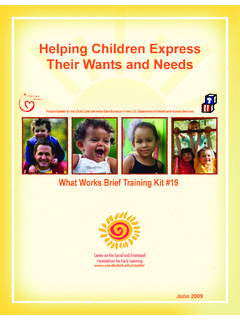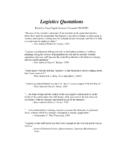Transcription of Evaluation Planning: What is it and how do you do it?
1 what We Know planning what We Know reports are a quick summary of new health communication research and trends of interest to CDC and its partners. They intend to keep health communication and marketing professionals up-to-date on new findings and their implications for public health communication. Brought to you by the Marketing and Communication Strategy Branch in the Division of Health Communication and Marketing, Centers for Disease Control and Prevention (CDC). Evaluation planning : what is it and how do you do it? Imagine that you or your research team has just completed a communication intervention designed to reduce smoking among adolescents.
2 Wouldn t you want to know if the intervention worked? That is where Evaluation comes in. In this case, we would be conducting a summative Evaluation (after the intervention) to answer questions such as: (1) Did rates of smoking among adolescents decrease?; (2) Did the radio ads reach enough teens to have statistical power?; (3) Did the ads affect norms about smoking in that age group?; (4) Was the cigarette tax increase during the Evaluation period the real reason that smoking decreased?; and (5) Did the ads boomerang by making teens think that smoking is more prevalent that it actually is in their age group? If the research team conducted a formative Evaluation (before and during the communication intervention), your team would be able to make any necessary changes such as edits to radio ads or when they are played before continuing forward.
3 If you re still feeling confused, don t worry; the purpose of this introductory section is to provide you with some useful background information on Evaluation planning . what is Evaluation ? Evaluations are, in a broad sense, concerned with the effectiveness of programs. While common sense Evaluation has a very long history, Evaluation research which relies on scientific methods is a young discipline that has grown massively in recent years (Spiel, 2001). Evaluation is a systematic process to understand what a program does and how well the program does it. Evaluation results can be used to maintain or improve program quality and to ensure that future planning can be more evidence-based. Evaluation constitutes part of an ongoing cycle of program planning , implementation, and improvement (Patton, 1987). 1 what We Know planning Make Evaluation part of your health communication program from the beginning; don t tack it on at the end!
4 The Evaluation experience is likely to be more positive and its results are likely to be more useful if you build Evaluation in from the start and make it an on-going activity. This includes planning the summative Evaluation before the intervention begins as part of the planning process, which helps to clarify program goals and reasonable outcomes. Taken together, you and your research team should know why the Evaluation is being undertaken ( , performance measurement or improvement) and the type of evidence that would be sufficient for your program and stakeholders. By evidence, we generally mean information helpful in forming a conclusion or judgment. In other words, evidence means information bearing on whether a belief or proposition is true or false, valid or invalid, warranted or unsupported (Schwandt, 2009). Recently there has been some confusion with understanding the term evidence in Evaluation because it is often taken to be synonymous with the term evidence-based.
5 Evidence-based, however, has two shortcomings: (1) it is narrowly interpreted to mean that only a specific kind of scientific finding, that is, evidence of causal efficacy, counts as evidence; (2) the idea of an evidence base suggests that evidence is the literal foundation for action because it provides secure knowledge (Upshur, 2002). what type of Evaluation should I conduct? Evaluation falls into one of two broad categories: formative and summative. Formative evaluations are conducted during program development and implementation and are useful if you want direction on how to best achieve your goals or improve your program. Summative evaluations should be completed once your programs are well established and will tell you to what extent the program is achieving its goals. Table 1 The types of Evaluation within formative and summative Evaluation : Formative Needs Assessment Determines who needs the communication program/intervention, how great the need is, and what can be done to best meet the need.
6 Involves audience research and informs audience segmentation and marketing mix (4 P s) strategies. Process Evaluation Measures effort and the direct outputs of programs/interventions what and how much was accomplished ( , exposure, reach, knowledge, attitudes, etc.). Examines the process of implementing the communication program/intervention and determines whether it is operating as planned. It can be done continuously or as a one-time assessment. Results are used to improve the program/intervention. Summative Outcome Evaluation Measures effect and changes that result from the campaign. Investigates to what extent the communication program/intervention is achieving its outcomes in the target populations. These outcomes are the short-term and medium-term changes in program participants that result directly from the program such as new knowledge and awareness, attitude change, beliefs, social norms, and behavior change, etc.
7 Also measures policy changes. Impact Evaluation Measures community-level change or longer-term results ( , changes in disease risk status, morbidity, and mortality) that have occurred as a result of the communication program/intervention. These impacts are the net effects, typically on the entire school, community, organization, society, or environment. 2 what We Know planning Table 2--Which of these evaluations is most appropriate depends on the stage of your program: If you are not clear on what you want to evaluate, consider doing a best practices review of your program before proceeding with your Evaluation . A best practices review determines the most efficient (least amount of effort) and effective (best results) way of accomplishing a task, based on repeatable procedures that have proven themselves over time for large numbers of people. This review is likely to identify program strengths and weaknesses, giving you important insight into what to focus your Evaluation on.
8 How do I conduct an Evaluation ? The following six steps are a starting point for tailoring an Evaluation to a particular public health effort at a particular time. In addition, the steps represent an ongoing cycle, rather than a linear sequence, and addressing each of the steps is an iterative process. For additional guidance, consult the Evaluation planning Worksheet in the Appendix of this document. As each step is discussed, examples from the Violence Against Women campaign implemented in Western Australia will be included. The Violence Against Women campaign was the first of its kind to target violent and potentially violent men. The campaign taught men that domestic violence is a problem which has negative effects on children and that specific help is available. Program coordinators decided not to apply traditional interventions often used in domestic violence cases because they have not been successful at changing behavior.
9 As a result, the communication intervention included: Publications, including self-help booklets providing tips on how to control violence and how to contact service providers; mass media advertising; public relations activities with stakeholders, including women s groups, police, counseling professions and other government departments; and posters and mailing to worksites (Hausman & Becker, 2000). 3 what We Know planning 1. Engage stakeholders This first step involves identifying and engaging stakeholders. These individuals have a vested interest in the Evaluation . Find out what they want to know and how they will use the information. Involve them in designing and/or conducting the Evaluation . For less involved stakeholders, keep them informed about activities through meetings, reports and other means of communication (CDC, 1999, 2008; McDonald et al.)
10 , 2001). EX: The program planners of the Violence Against Women campaign included internal and external partners as stakeholders. Internal partners were the Director of the Domestic Violence Prevention Unit and the Family and Domestic Violence Task Force. External partners were experts in the field of social marketing/behavior change, health promotions, communication, and women s issues; the Department of Family and Children s Services; service providers including trained counselors, therapists and social workers; and the police. The program planners kept in touch with stakeholders and got input from them throughout the campaign (Turning Point Social Marketing Collaborative, Centers for Disease Control and Prevention, and Academy for Educational Development, 2005). 2. Identify program elements to monitor In this step you and/or the team decides what s worth monitoring.



















